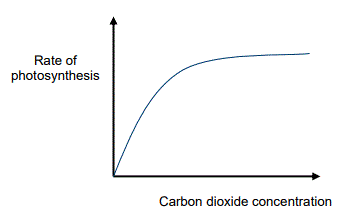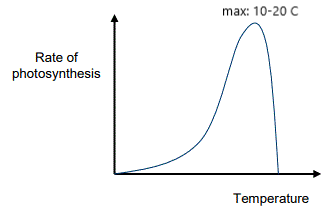Variables that affect the rate of photosynthesis: There are several factors that affect the rate of
photosynthesis (or how fast sugars are produced in plants). These include: (a) light intensity (brightness),
(b) carbon dioxide concentration, (c) temperature, and (d)
light wavelength.
The relationship between light intensity and photosynthesis is shown in the graph below.
-
Light intensity (amount/brightness of light). When there is no light, no photosynthesis takes place. As
the
light intensity increases from zero, the rate of photosynthesis
increases. After a certain point, the rate of photosynthesis will not increase any more with increasing
light intensity.
-
Carbon Dioxide concentration. When there is no CO2, photosynthesis does not occur.
Increasing the concentration of Carbon Dioxide will increase the rate of photosynthesis. But after
a certain point, the rate of photosynthesis will not increase any more as CO2
concentration increases.

So, after a certain point, more carbon dioxide in the air will no longer help plants grow.
-
Temperature. The relationship between temperature and rate of photosynthesis
is different from the others. Again, when the temperature is very low, no photosynthesis
occurs. The increase in photosynthesis rate is slow at first, but starts to increase
more quickly at a certain point. The rate of photosynthesis is highest between 10
and 20°C (or 50-68°F). After this maximum, the photosynthesis
rate drops off quickly as the temperature increases. At around 40°C (or 104°F),
photosynthesis stops. As a result, plants cannot grow anymore.

-
Why does photosynthesis stop at high temperatures? There are certain molecules called "enzymes" made
by living organisms. Enzymes speed up
chemical reactions.
Chlorophyll is one enzyme that helps cause photosynthesis. Another enzyme, called RuBisCo, has the job of
capturing CO2. When the temperature is too high, RuBisCo gets very bad at capturing
CO2, which is needed for photosynthesis. As a result, photosynthesis stops.

